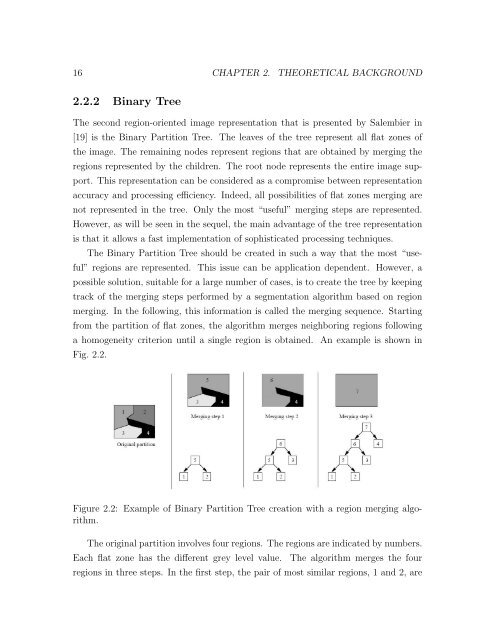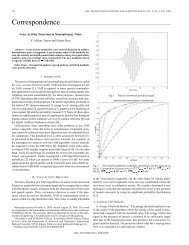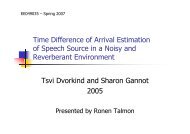Thesis (PDF) - Signal & Image Processing Lab
Thesis (PDF) - Signal & Image Processing Lab
Thesis (PDF) - Signal & Image Processing Lab
You also want an ePaper? Increase the reach of your titles
YUMPU automatically turns print PDFs into web optimized ePapers that Google loves.
16 CHAPTER 2. THEORETICAL BACKGROUND<br />
2.2.2 Binary Tree<br />
The second region-oriented image representation that is presented by Salembier in<br />
[19] is the Binary Partition Tree. The leaves of the tree represent all flat zones of<br />
the image. The remaining nodes represent regions that are obtained by merging the<br />
regions represented by the children. The root node represents the entire image sup-<br />
port. This representation can be considered as a compromise between representation<br />
accuracy and processing efficiency. Indeed, all possibilities of flat zones merging are<br />
not represented in the tree. Only the most “useful” merging steps are represented.<br />
However, as will be seen in the sequel, the main advantage of the tree representation<br />
is that it allows a fast implementation of sophisticated processing techniques.<br />
The Binary Partition Tree should be created in such a way that the most “use-<br />
ful” regions are represented. This issue can be application dependent. However, a<br />
possible solution, suitable for a large number of cases, is to create the tree by keeping<br />
track of the merging steps performed by a segmentation algorithm based on region<br />
merging. In the following, this information is called the merging sequence. Starting<br />
from the partition of flat zones, the algorithm merges neighboring regions following<br />
a homogeneity criterion until a single region is obtained. An example is shown in<br />
Fig. 2.2.<br />
Figure 2.2: Example of Binary Partition Tree creation with a region merging algorithm.<br />
The original partition involves four regions. The regions are indicated by numbers.<br />
Each flat zone has the different grey level value. The algorithm merges the four<br />
regions in three steps. In the first step, the pair of most similar regions, 1 and 2, are
















